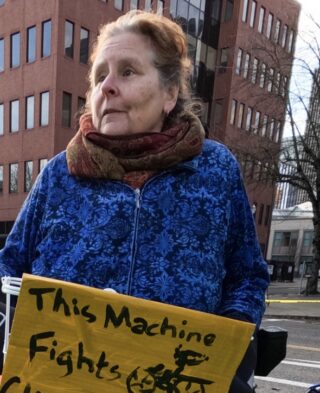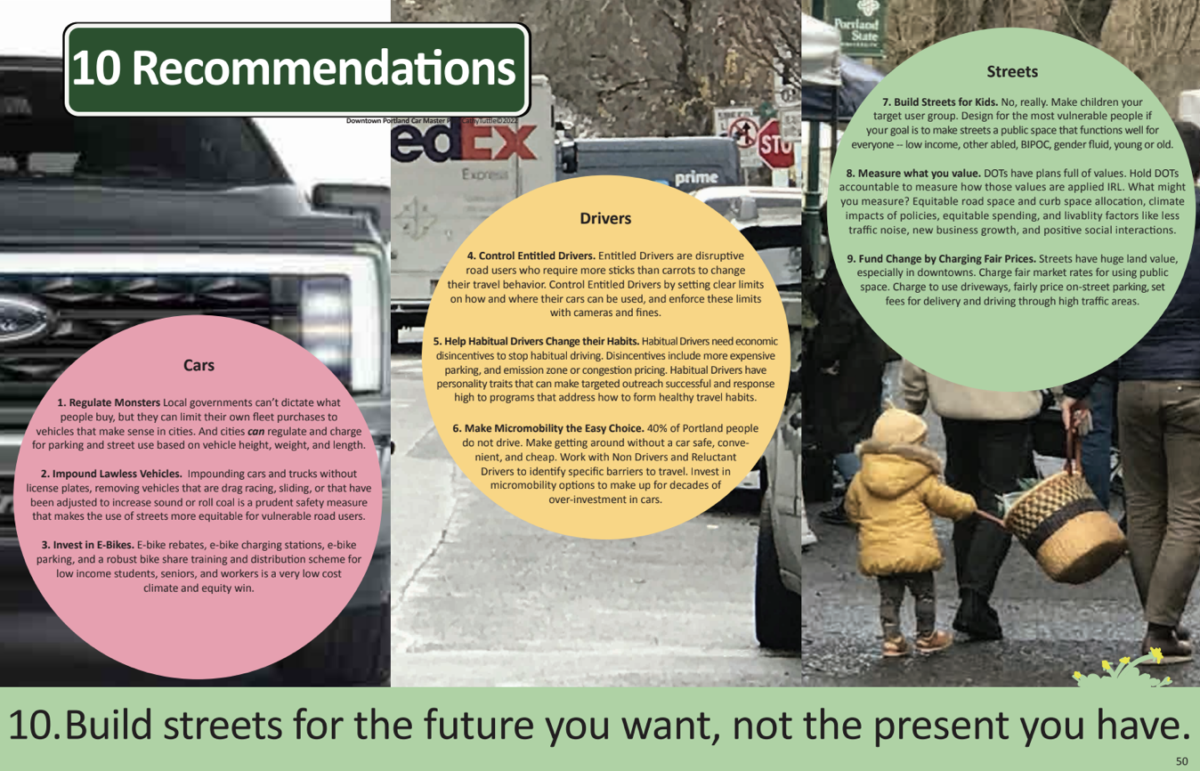Cycling News & Blog Articles
Cathy Tuttle’s ‘Car Master Plan’ turns city mode shift plan on its head
“We can’t plan for a future without looking at where we are now. And where we are now is in a city of cars.” — Cathy Tuttle, PhD
The city of Portland ostensibly wants people to start driving cars a lot less, and fast. The Portland Bureau of Transportation’s Bicycle Plan for 2030, finalized in 2010, conceived of a future in which 25% of all trips around Portland were done by bicycle. With 8 years to go to reach this goal, we haven’t been doing very well.
Could part of the problem be that we’re making master plans for the wrong things?
In a recent Friday Transportation Seminar presentation hosted by Portland State University’s Transportation Research and Education Center, longtime urban planner and local bicycling advocate Cathy Tuttle, PhD spoke about the importance of a “Car Master Plan”: a.k.a., a plan for making cities less car-oriented that actually focuses on the subject in question: the cars themselves, and the people who drive them.
Tuttle said American cities, including Portland, have a plethora of master plans for things like walking, biking, transit and freight, and all of them are written in response to cars.
Advertisement
“Right now, the car is the default design vehicle and car drivers are the default road users of all transportation plans. We plan all transportation – whether it’s bike, pedestrian freight or transit – from a car perspective,” Tuttle said in the presentation.
In order to shift the paradigm, Tuttle said cities need to acknowledge the impact cars have on cities, focusing on them the same way they focus on other mode types. Tuttle has written a Car Master Plan for Downtown Portland, which she shared during the presentation Friday. It’s a very deep dive into the history and culture of car dominance in the United States and the Portland area specifically, presenting complex ideas in a uniquely accessible way and making concrete suggestions for giving cities a car detox.
Although Tuttle has decades of experience in urban planning, she said she was surprised by some of her findings while writing this plan. Some of these surprises include how much money people in Oregon spend on their cars (an astonishing $40 billion), the fact that so-called “entitled drivers” often receive little to no punishment even if they kill someone while driving a car and just how much carbon a single gallon of gas will emit into the atmosphere when burned in a car’s gas tank.
Tuttle’s exploration into the “four types of Portland drivers” (above) was an especially fascinating element of the presentation. This theory was inspired by Portland Bureau of Transportation Bike Coordinator Roger Geller’s theory of the four categories of Portland cyclists, which he developed in 2006.
The reason Tuttle’s description of these archetypal Portland drivers (illustrated below) is so interesting is because, unlike some other elements of urban and transportation planning, most people in the U.S. have likely formulated a strong opinion about this topic – if only subconsciously.
In Tuttle’s presentation, which you can watch here, she elaborates on these four car driver types, providing recognizable stories about who these people are. For instance, Tuttle said the “Habitual Driver,” a type of car driver who drives mostly because it’s convenient, makes up about 30% of the general population.
Advertisement
Tuttle says the “Habitual Driver” is the reason MAX stations, schools, parks, grocery stores, coffee shops, gyms, and churches are surrounded by acres of free parking, and why residential streets are lined with cars.
Tuttle’s plan also includes detailed information about Portland’s streets – the nitty-gritty engineering logistics of them, how much it costs to maintain them for cars and just how much space they take up.
She also talks about cars themselves – what they’re made of, how much they cost, their growing potential to kill as they’re manufactured larger and larger and their secured place the American status symbol.
“Cars are sex symbols, imbuing their owner with glamour. Cars are security devices, keeping families safe as they get to the next soccer practice. Cars are places to be alone, blasting music on the open road. Cars are cute, rugged, professional, menacing, powerful. Cars are just expensive metal boxes that dominate our shared public space,” Tuttle writes in her report.
Ultimately, Tuttle’s plan provides a roadmap for seeing Portland, and cities across the country, through a radically different lens than the car-dominant one most people are used to.
“Why make a Car Master Plan? So we can see cars. We don’t see what we don’t measure,” Tuttle writes. “We can’t plan for a future without looking at where we are now. And where we are now is in a city of cars.”
The presentation goes into more detail about the intricacies of car culture and how it affects Portland on every level, and she also has a set of recommendations (below). The slides are available here, and you can learn more about Tuttle by listening to our podcast interview with her from earlier this year.
Taylor has been BikePortland’s staff writer since November 2021. She has also written for Street Roots and Eugene Weekly. Contact her at This email address is being protected from spambots. You need JavaScript enabled to view it.





